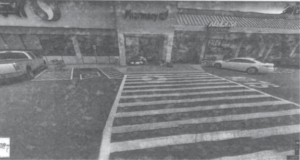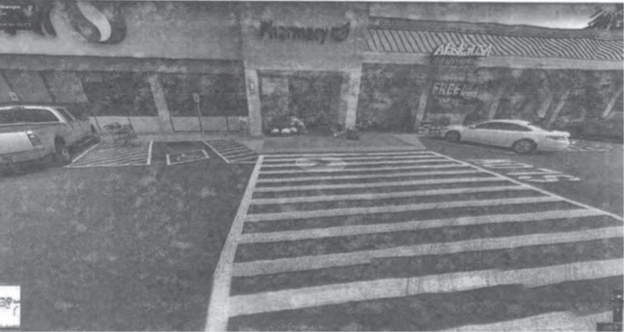A parking space angled into a crosswalk directly behind it, so that any driver pulling out of the parking space must pull directly into a parking lot crosswalk. See where this is going?
A customer used the painted crosswalk to walk towards an entrance to Value Village in Marysville. A customer backed a minivan from the diagonal parking space into the crosswalk and struck the customer walking through. The customer suffered traumatic brain injury.

The case was somewhat complicated by the leasing history. A commercial landlord owned the property and retained a property management company to manage its commercial rentals. The space the customer was walking towards was originally leased to Safeway, who years later subleased it. The sub-lease was later assigned. Safeway retained certain rights and responsibilities under the sub-leasing agreements.
The customer sued the various landlord, property management, the tenant, and the sub-tenant, as well as the driver. The property management firm and sub-tenant filed a motion for summary judgment. The injured customer appealed.
The Court of Appeals upheld the dismissal of the property management firm but reversed the dismissal of the sub-tenant.[1]
A landowner has a duty to maintain common areas in a reasonably safe condition. But a landowner may not be liable for injury on its property if it has given exclusive control of the property to a tenant. To determine premises liability Washington courts look to whether a defendant is a possessor of property, not whether the defendant is a true owner.
A possessor is a person occupies or has the right to occupy real property with intent to control it. A person is in “control” of real property if that person has the authority and ability to take precautions to reduce the risk of harm to entrants on the land. Control may be shared.
In this case, the property management was not in possession nor had any right to possession of the commercial rental space. Also, the property management firm had no authority to make alterations to the property without the approval of the landlord.
The sub-tenant as a store proprietor had a duty to exercise reasonable care to keep those portions of the premises used by their customers in a reasonably safe condition or to warn the customer-invitees of the dangerous condition. This includes a legal obligation to use ordinary care to keep the approaches, entrances, and exits in a reasonably safe condition for the use of customers who are entering or leaving the business. The duty to business invitees of safe ingress and egress arises even if the proprietor does not own or control the property on which the hazard is located.
Thus, where a ditch next to the entrance to a gas station was difficult to see, the gas station was negligent for failing to post warnings or provide adequate lighting to make the ditch visible to those entering the service station.[2]
In the case at hand, the Court of Appeals noted that several experts testified that the design of the handicap parking stall is dangerous to pedestrians because it requires drivers who want to drive north out of the parking lot to back into the crosswalk when pulling out of the space. The experts opined that the sub-tenant should have known about the poor design and sought to correct the problem. This was a material issue of fact that should have been heard by a jury.
Many people assume that if someone was injured on another’s property that the owners, managers, and commercial tenants are liable. As this case illustrates, whether and which parties might be liable for injury is often less than straightforward.
If you have been injured on someone else's property, a property owner or commercial tenant may be responsible. Consult with an attorney to learn more.
[1] Carney v. Pacific Realty Associates, LP, No. 80057-4-I (Wa. Ct. App. Div. 1 8/31/2020).
[2] Rockefeller v. Standard Oil Co. of Cal., 11 Wn. App. 520, 523 P.2d 1207 (1974).
